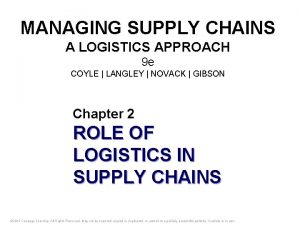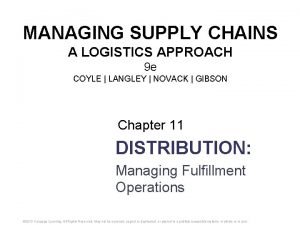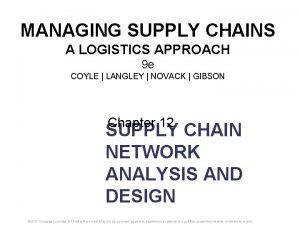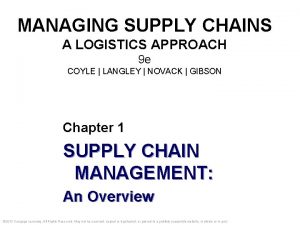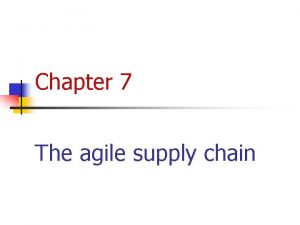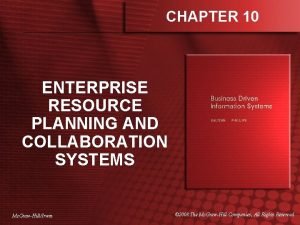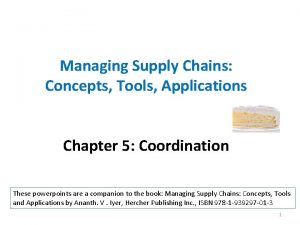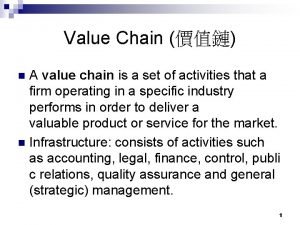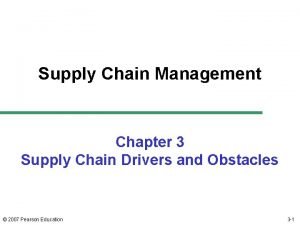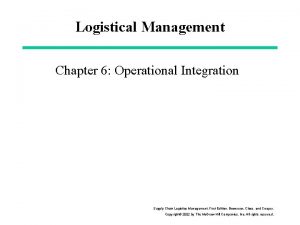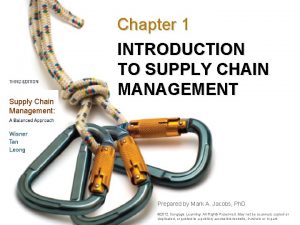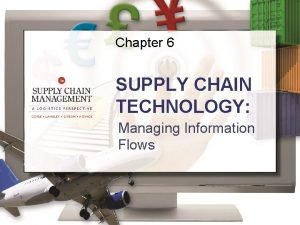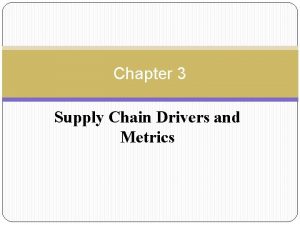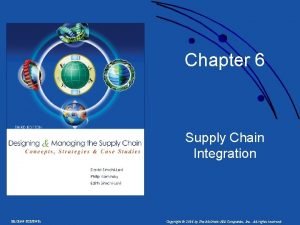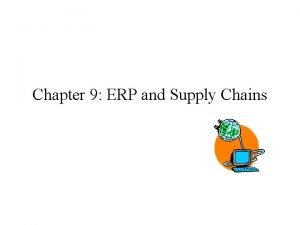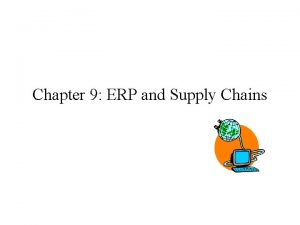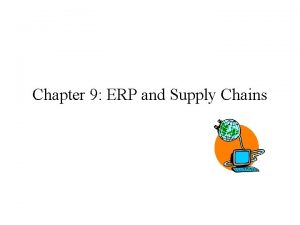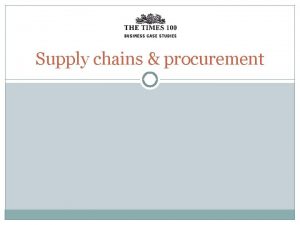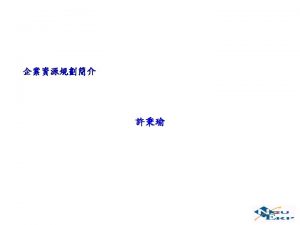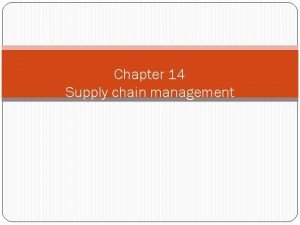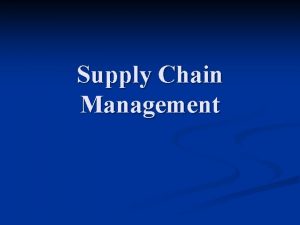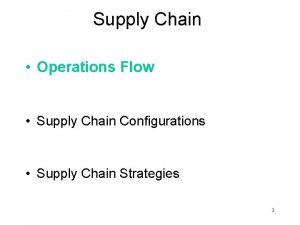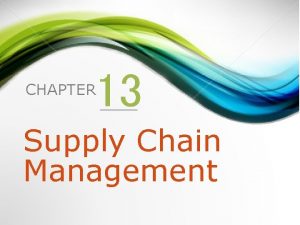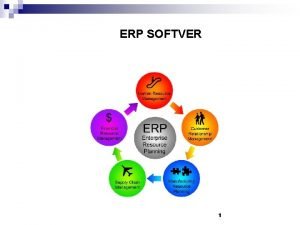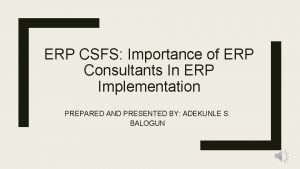Chapter 9 ERP Supply Chains Supply Chain support





![ERP Restrictions • Internally focused ERP can constrain supply chain coordination (Davenport [2000]) – ERP Restrictions • Internally focused ERP can constrain supply chain coordination (Davenport [2000]) –](https://slidetodoc.com/presentation_image_h2/905af10f9177ff404851f14f88fc8cf5/image-6.jpg)





![On-Line Marketplaces Manetti [2001] TARGET MARKET Vertical Deep & narrow product access Multivertical Multiple On-Line Marketplaces Manetti [2001] TARGET MARKET Vertical Deep & narrow product access Multivertical Multiple](https://slidetodoc.com/presentation_image_h2/905af10f9177ff404851f14f88fc8cf5/image-12.jpg)


![Discrete Manufacturing Lean Business Strategies Bradford et al. [2001] Build-to-stock Customer orders filled from Discrete Manufacturing Lean Business Strategies Bradford et al. [2001] Build-to-stock Customer orders filled from](https://slidetodoc.com/presentation_image_h2/905af10f9177ff404851f14f88fc8cf5/image-15.jpg)
![Continuous Manufacturing Lean Business Strategies Bradford et al. [2001] Make-to-Stock Customer orders filled from Continuous Manufacturing Lean Business Strategies Bradford et al. [2001] Make-to-Stock Customer orders filled from](https://slidetodoc.com/presentation_image_h2/905af10f9177ff404851f14f88fc8cf5/image-16.jpg)


- Slides: 18

Chapter 9 ERP & Supply Chains Supply Chain support Lean Manufacturing

Supply Chains • Collections of organizations working together – Raw materials – products – retail – Old manufacturing: vertical integration – Military logistics – Now appropriate for e-business

Vertical Integration • Closely coordinate supply chain internally – Steel, petroleum • Open form: not one owner group – Automobiles • Can tie computer systems together in similar manner – ERP provides detailed data needed for close coordination

Supply Chain Advantages • Competitive advantage – Cost • Production efficiencies – Value • Logistic efficiencies • Coordinated advertising • Large scale service

ERP Motivations • Supply chain relationships provide – Improved interactions & communications – With suppliers & customers • Mabert et al. [2000]: – 20% of manufacturers surveyed had supply chain extensions to ERP – 25% more planned to
![ERP Restrictions Internally focused ERP can constrain supply chain coordination Davenport 2000 ERP Restrictions • Internally focused ERP can constrain supply chain coordination (Davenport [2000]) –](https://slidetodoc.com/presentation_image_h2/905af10f9177ff404851f14f88fc8cf5/image-6.jpg)
ERP Restrictions • Internally focused ERP can constrain supply chain coordination (Davenport [2000]) – Long-run ERP need for supply chain – In short-run, ERP a hindrance to supply chain (Bowersox et al. [1999]) • ERP systems provide integrated information – Unless all units use the same system, a barrier to communication

System Openness • Supply chains require open systems • Original ERP assumed a small number of users accessing system – Seat pricing mechanism encouraged

Organizational Openness Extended Enterprise Cooperative Enterprise Traditional Company Profile Agile Lean Profit focus Strategy Adaptive Value maximizing Cost minimizing Goal Emphasis Flexibility Effectiveness Efficiency Operations Collaborative, open Selective sharing Limited sharing Planning Joint performance measure From push to pull Push Relationships Extended alliances Qualified relationships Limited sharing Technology Linked No ERP link Selected SCM

Advanced Planning Systems • Computer technology makes supply chain capable of dealing with demand uncertainty – Forecasting – Inventory reduction – Optimized transportation costs • Advanced planning systems use operational data to analyze material flows in supply chain – Use historical demand forecasts – Easy to collect data – Dynamic nature makes long-range forecasting difficult

Advanced Planning System Providers i 2 Manugistics Numetrix CAPS logistics BAAN J. D. Edwards Oracle People. Soft SAP SCM components 11 i Enterprise Performance Management SAP APO

ERP Vendor Response • my. SAP. com an open, collaborative system – Integrates SAP & non-SAP software • SAP APO – supports forecasting, scheduling, other logistics activities • People. Soft: Enterprise Performance Management • JDEdwards – products for planning & execution • Oracle’s 11 i Advanced Planning & Scheduling
![OnLine Marketplaces Manetti 2001 TARGET MARKET Vertical Deep narrow product access Multivertical Multiple On-Line Marketplaces Manetti [2001] TARGET MARKET Vertical Deep & narrow product access Multivertical Multiple](https://slidetodoc.com/presentation_image_h2/905af10f9177ff404851f14f88fc8cf5/image-12.jpg)
On-Line Marketplaces Manetti [2001] TARGET MARKET Vertical Deep & narrow product access Multivertical Multiple vertical sites Horizontal Broader, more extensive linkage TRANSACTION METHOD Auction based Exchange for simultaneous bids Future contract variants For risk reduction Pure auction systems To establish prices for buyers Reverse auctions To establish prices for sellers Metacatalogs Reduce search costs Mall-based Access multiple suppliers at single site

Lean Manufacturing • Toyota bundle of techniques from 1950 s • Common supply chain philosophy – Cut waste by eliminating activities that don’t add value • Continuous product flows without bottlenecks – Produce to order • (demand pull, not supply push) – Emphasize quality

ERP & Lean Manufacturing • Initial ERP applications did little for efficiency – Complex bills of material – Inefficient workflows – Unnecessary data collection • Efforts by ERP vendors to support lean manufacturing – Not all manufacturers were convinced • Lean manufacturing features – Demand smoothing – Kanban replenishment calculation – Exception reporting
![Discrete Manufacturing Lean Business Strategies Bradford et al 2001 Buildtostock Customer orders filled from Discrete Manufacturing Lean Business Strategies Bradford et al. [2001] Build-to-stock Customer orders filled from](https://slidetodoc.com/presentation_image_h2/905af10f9177ff404851f14f88fc8cf5/image-15.jpg)
Discrete Manufacturing Lean Business Strategies Bradford et al. [2001] Build-to-stock Customer orders filled from existing finished goods inventory Configure-to-order Products assembled to order from pre-built components Assemble-to-order Batch formulated to fill specific order from pre-built components Engineer-to-order Each order designed to customer specifications
![Continuous Manufacturing Lean Business Strategies Bradford et al 2001 MaketoStock Customer orders filled from Continuous Manufacturing Lean Business Strategies Bradford et al. [2001] Make-to-Stock Customer orders filled from](https://slidetodoc.com/presentation_image_h2/905af10f9177ff404851f14f88fc8cf5/image-16.jpg)
Continuous Manufacturing Lean Business Strategies Bradford et al. [2001] Make-to-Stock Customer orders filled from existing inventory Configure-to. Order Batches mixed in common, packaged & processed for specific orders Batch formulated to specific order Make-to-Order

Key Trends Akkermans et al. (2003) 1. Further integration of suppliers & customers 2. Focus on ERP system flexibility 3. Mass customization • Standard interfaces across chain

Summary • Vertical integration historically used to make supply chains efficient • Today supply chain efficiency gained by linking specialists across organizations • ERP initially focused on integrating internal operations – High investment, rigid procedures barriers to supply chains – Trends more supportive • Advanced Planning Systems • Vendor software • Lean manufacturing support
 Ppt index
Ppt index Food chain sequence
Food chain sequence What is logistics management
What is logistics management Managing supply chains a logistics approach
Managing supply chains a logistics approach Managing supply chains: a logistics approach
Managing supply chains: a logistics approach Managing supply chains a logistics approach
Managing supply chains a logistics approach Managing supply chains a logistics approach
Managing supply chains a logistics approach An integrated model for the design of agile supply chains
An integrated model for the design of agile supply chains Matching supply with demand
Matching supply with demand Scm, crm, and erp are all extended erp components.
Scm, crm, and erp are all extended erp components. Erp system support
Erp system support Take or pay contract
Take or pay contract Value chain framework in erp
Value chain framework in erp Drivers for lean supply chain
Drivers for lean supply chain The great divide supply chain management
The great divide supply chain management Chapter 1 supply chain management
Chapter 1 supply chain management Chapter 6 supply chain management
Chapter 6 supply chain management Drivers of supply chain
Drivers of supply chain Chapter 6 supply chain management
Chapter 6 supply chain management



